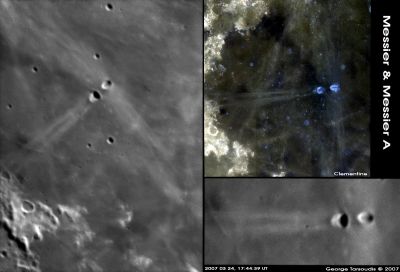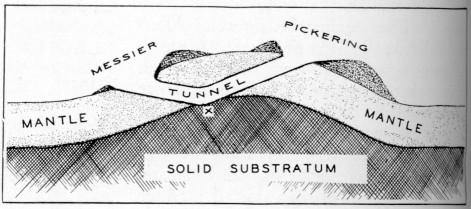Messier
Contents
Messier
|
Lat: 1.9°S, Long: 47.64°E, Diam: 13.7 km, Depth: 1.9 km, Rükl 48, Copernican |

George Tarsoudis Messier is the right-most member of the crater pair shown in these images. Its slightly larger-appearing companion on the left is Messier A.
Images
LPOD Photo Gallery Lunar Orbiter Images Apollo Images ASU Apollo Image Archive
- AS15-81-10990 (close-up of Messier ) is included in the book Full Moon by Michael Light and Andrew Chaikin (Plate 33).
- AS16-122-19535 is one of seven photographs which show the rotation of the Ascent Stage of Apollo 16's LM Orion during Stations-Keeping (before docking). Note the Messier twins at right!
- Frame 5041, made by Lunar Orbiter 5, shows an oblique westward view of both Messier and Messier A. Note the bright retro-reflection ("Heiligenschein") near the horizon.
- AS10-29-4256HR shows an oblique south-southwest looking view of both the Messiers with Messier B in the foreground (source: Apollo 10 Flight Journal, David Woods).
- AS10-33-4906 is a south up hand-held Apollo view.
- AS10-35-5205, made through one of the small windows of Apollo 10's CM Charlie Brown, shows the Messier twins' and one of LM Snoopys four nozzle clusters (bottom right corner).
- AS11-44-6616 is one of Apollo 11's un-labeled orbital Hasselblad photographs which show both craters Messier and Messier A near the frame's lower right corner.
- Apollo 15's panoramic stereo frames AS15-P-10122 and 10127 show a southward look at the pair Messier/ Messier A.
- Research Apollo and Lunar Orbiter photographs: Danny Caes
Maps
(LAC zone 79B2) LAC map Geologic map AIC map LTO map
Description
Elger
(IAU Directions) MESSIER.--The more easterly of a remarkable pair of bright craters, about 9 miles in diameter, standing in an isolated position in the Mare Fecunditatis just S. of the Equator. Madler represents them as similar in every respect, but Webb, observing them in 1855 and 1856 with a 3 7/10 achromatic, found them very distinctly different,--Messier, the more easterly, being not only clearly smaller than its companion, but longer from E. to W. than from N. to S., as it undoubtedly is at the present time. Messier A, however, as the companion is termed, though larger, is certainly not circular, as sometimes shown, but triangular with curved sides. It is just possible that change may have occurred here, for Madler carefully observed these objects more than three hundred times, and, it may be presumed, under very different phases. Messier A is the origin of two slightly divergent light streaks, resembling a comet's tail, which extend over the Mare towards its W. border N. of Lubbock, and are crossed obliquely by a narrower streak. Messier and Messier A stand near the S. and narrowest end of a tapering curved light area. There is a number of craterlets and minute pits in the neighbourhood, and under a high light two round dusky spots are traceable in connection with the "comet" marking, one just beyond its northern, and the other beyond its southern border, near its W. extremity.
Wikipedia
Additional Information
- IAU page: Messier
- Depth data from Kurt Fisher database
- Pike, 1976: 1.9 km
- Westfall, 2000: 1.9 km
- Cherrington, 1969: 1.24 km
- Included in the ALPO list of bright ray craters
- Included in the ALPO list of banded craters
- Messier and Messier A, D & G are thermal anomaly craters, implying youthful ages - Moore et al, 1980
 In the early 1950's, famed American meteorite specialist H. H. H. Nininger advanced the hypothesis that the pair Messier and Messier A (then known as W. H. Pickering) was formed by a relatively small impactor tunneling through the unnamed mare ridge on opposite sides of which they appear to reside (and which he dubbed the Tunnel Ridge). The image (click to see a larger version) is taken from his 1952 article in Sky and Telescope. Nininger believed the projectile had burrowed at a shallow angle into a layer of loosely compacted lunar soil, several thousand feet thick and many miles long (but with a density gravitationally equivalent to pine or cork dust on Earth), ricocheting off a more substantial layer below the apparent surface; entering at Messier and exiting at Messier A and forming a melted tube as it passed between them. Modern photos, of course, show no evidence of connecting tube. - Jim Mosher
In the early 1950's, famed American meteorite specialist H. H. H. Nininger advanced the hypothesis that the pair Messier and Messier A (then known as W. H. Pickering) was formed by a relatively small impactor tunneling through the unnamed mare ridge on opposite sides of which they appear to reside (and which he dubbed the Tunnel Ridge). The image (click to see a larger version) is taken from his 1952 article in Sky and Telescope. Nininger believed the projectile had burrowed at a shallow angle into a layer of loosely compacted lunar soil, several thousand feet thick and many miles long (but with a density gravitationally equivalent to pine or cork dust on Earth), ricocheting off a more substantial layer below the apparent surface; entering at Messier and exiting at Messier A and forming a melted tube as it passed between them. Modern photos, of course, show no evidence of connecting tube. - Jim Mosher
Nomenclature
- Named for Charles Messier (June 26, 1730 – April 12, 1817), a French astronomer who in 1774 published a catalogue of 45 deep sky objects such as nebulae and star clusters. The purpose of the catalogue was to help comet hunters (like himself) and other astronomical observers to distinguish between permanent and transient objects in the sky.
- According to Mary Blagg's Collated List of 1913, this crater (catalog entry 4254) was known to Beer and Mädler, and to Neison, as Messier. Schmidt called it Messier West (see the note on IAU directions).
- The name Messier was selected for the original IAU nomenclature of Blagg and Müller (1935), where it is attributed to Mädler.
- On his map, Gruithuisen had used the name Cometicus for Messier, Messier A and their rays (Whitaker, p. 112).
LPOD Articles
Uncommon Perspective
Butterfly Wings & Railway Tracks
A Comet and a Butterfly
Stunning
A Tunnel Thru the Moon
Fertility Central
APOD Articles
Messier craters in Stereo (Red-Cyanblue anaglyph of orbital Apollo 11 photograph, by Patrick Vantuyne).
Lunar 100
L25: Oblique ricochet-impact pair.
LROC Articles
Mare Pit Topography! (the small Skylight immediately east of Messier B, unofficially called the Central Mare Fecunditatis Pit).
Bibliography
- Hill, Harold. A Portfolio of Lunar Drawings, pages 210, 211, 212, 213, 214.
- Nininger, H. H. 1952. Do We See a Lunar Tunnel?. Sky and Telescope, volume 11, pp. 192-3 (June issue).
- Apollo Over the Moon, Chapter 5: Craters (Part 2), Figure 115.
Messier G and environs:
- Apollo Over the Moon, Chapter 4: The Maria (Part 2), Figure 73.
Charles Messier in the Sourcebook Project (William R. Corliss)
- Page 2 in Mysterious Universe, a handbook of astronomical anomalies (1979) :
- An Account of a Very Singular Phenomenon seen in the Disc of the Sun (Annual Register, 1766) (in this article, Messier is mentioned as Meffier).
Named Features -- Prev: Messala -- Next: Rima Messier